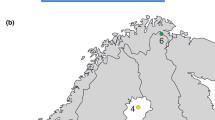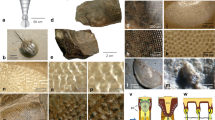Summary
Each of the approximately 500 ommatidia in the compound eye of the cladoceran crustacean Leptodora kindtii has a crystalline cone consisting of five cells. Five retinula cells are also present, one of which contributes to the distal 1–2 μm of the rhabdom only; the other four retinula cells form a continuous rhabdom. Throughout the rhabdom its cross section displays two separate halves with the axis of the microvilli in one half perpendicular to that in the other (orthogonal pattern). Interferometric analysis of the refractive index of the crystalline cone revealed an inhomogeneous system with one distal and one proximal gradient. The gradient system was found to exclude rays entering from adjacent facets, thus maintaining the optical isolation. Consequently, these optics replace distal screening pigment, which is absent in the eye. The long and unscreened crystalline cones give rise to an almost transparent eye in conformity with the overall transparency of this planktonic animal.
The morphological characteristics of the eye of this species deviate from other cladoceran eyes, but the optical design closely resembles that of some pelagic marine amphipod crustaceans.
Similar content being viewed by others
References
Andersson A (1979) Cerebral sensory organs in ostracodes (Crustacea). Thesis, Lund
Ball EE (1977) Fine structure of the compound eyes of the midwater amphipod Phronima in relation to behaviour and habitat. Tissue Cell 9:521–536
Debaisieux P (1944) Les yeux des Crustacées, structure, développement, réactions à l'éclairement. Cellule 50:9–122
Elofsson R, Odselius R (1975) The anostracan rhabdom and the basement membrane. An ultrastructural study of the Artemia compound eye (Crustacea). Acta Zool 56:141–153
Güldner F-H, Wolff JR (1970) Über die Ultrastruktur des Komplexauges von Daphnia pulex. Z Zellforsch 104:259–274
Hallberg E (1977) The fine structure of the compound eyes of mysids (Crustacea: Mysidacea). Cell Tissue Res 184:45–65
Hallberg E, Elofsson R (1982) The larval compound eye of barnacles. J Crust Biol, in press
Hallberg E, Nilsson HL, Elofsson R (1980) Classification of amphipod compound eyes the fine structure of the ommatidial units (Crustacea, Amphipoda). Zoomorphologie 94:279–306
Karnovsky MJ (1965) A formaldehyde-glutaraldehyde fixative of high osmolarity for use in electron microscopy. J Cell Biol 27:137 A-138 A
Land MF (1981) Optics of the eyes of Phronima and other deep-sea amphipods. J Comp Physiol 145:209–226
Meggitt S, Meyer-Rochow VB (1975) Two calculations on optically nonhomogeneous lenses. In: Horridge GA (ed) The compound eye and vision of insects. Clarendon Press, Oxford, pp 314–320
Nilsson D-E (1982) The transparent compound eye of Hyperia (Crustacea). Examination with a new method for analysis of refractive index gradients. J Comp Physiol 147:339–349
Nilsson D-E, Odselius R (1981) A new mechanism for light-dark adaptation in the Artemia compound eye. J Comp Physiol 143:389–399
Nilsson D-E, Odselius R (1983) Regionally different optical systems in the compound eye of the water-flea Polyphemus (Cladocera, Crustacea). Proc R Soc Lond B 217, in press
Nowikoff M (1905) Über die Augen und Frontalorgane der Branchiopoda. Z wiss Zool 79:432–464
Odselius R, Nilsson D-E (1983) Regionally different ommatidial structure in the compound eye of the water-flea Polyphemus (Cladocera, Crustacea). Proc R Soc Lond B 217, in press
Paulus HF (1979) Eye structure and the monophyly of the Arthropoda. In: Gupta AP (ed) Arthropod phylogeny. Van Nostrand Reinhold Co, New York, pp 299–383
Snyder AW, Stavenga DG, Laughlin SB (1977) Spatial information capacity of compound eyes. J Comp Physiol 116:183–207
Waterman TH (1961) Light sensitivity and vision. In: Waterman TH (ed) The physiology of Crustacea vol II. Academic Press, New York, London, pp 1–64
Wingstrand KG (1978) Comparative spermatology of the Crustacea Entomostraca 1. Subclass Branchiopoda. Biol Skr Dan Vidensk Selsk 22:1–67
Wolken JJ, Gallik GJ (1965) The compound eye of a crustacean, Leptodora kindtii. J Cell Biol 26:968–973
Author information
Authors and Affiliations
Rights and permissions
About this article
Cite this article
Nilsson, DE., Odselius, R. & Elofsson, R. The compound eye of Leptodora kindtii (Cladocera). Cell Tissue Res. 230, 401–410 (1983). https://doi.org/10.1007/BF00213813
Accepted:
Issue Date:
DOI: https://doi.org/10.1007/BF00213813




